How the Cubs were built: Turning baseball's longest-running losers into winners

Graphics by Lindsay Applebaum and Allen Kim. Introductory text by Ted Keith.
In 2011, the Cubs stumbled to a 71–91 record. Just three years earlier, they had led the National League with 97 wins and won their second straight NL Central title. Both of those seasons ended with NLDS sweeps—to the Diamondbacks and the Dodgers, respectively—followed by three straight years of mounting losses from 2009 to ’11, despite Chicago having one of the league's two highest payrolls each season. In August of that latter year, longtime general manager Jim Hendry was fired by owner Tom Ricketts, who had purchased the club in 2009 for almost $900 million.
Ricketts went looking for the executive who could build a team that would end the franchise's infamous World Series drought—one that stretches back to 1908. He found just who he was looking for in Theo Epstein, who as GM of the Red Sox had put together the club that in 2004 ended Boston’s 86-year quest for a title.
On Oct. 12, 2011, Epstein was hired as Chicago’s President of Baseball Operations. Padres GM Jed Hoyer and assistant GM Jason McLeod, both former Epstein lieutenants in Boston, were quickly brought over as general manager and director of scouting, respectively. On Oct. 25, at the press conference announcing his hiring, Epstein said, “I firmly believe that we can ... build a consistent winner, a team that will be playing baseball in October and a team that ultimately will win the World Series.”
The first move in that journey was compensation for Epstein, who had had one year left on his contract in Boston. For minor league pitchers Chris Carpenter and Aaron Kurcz—plus a five-year, $18.5 million contract—the Cubs got their man. In 2012, the new regime’s first year, Chicago lost 101 games, the first time the franchise had broken 100 since 1966, and in '13, it lost 96. But the Cubs went 73–89 in 2014, and after the season, Epstein made one of the most significant acquisitions of his tenure, hiring Joe Maddon to be the manager. With the calm and experienced Maddon guiding the club, Chicago went 97–65 in 2015, winning the NL’s second wild card and beating the arch-rival Cardinals in the NLDS before being swept by the Mets in the NLCS.
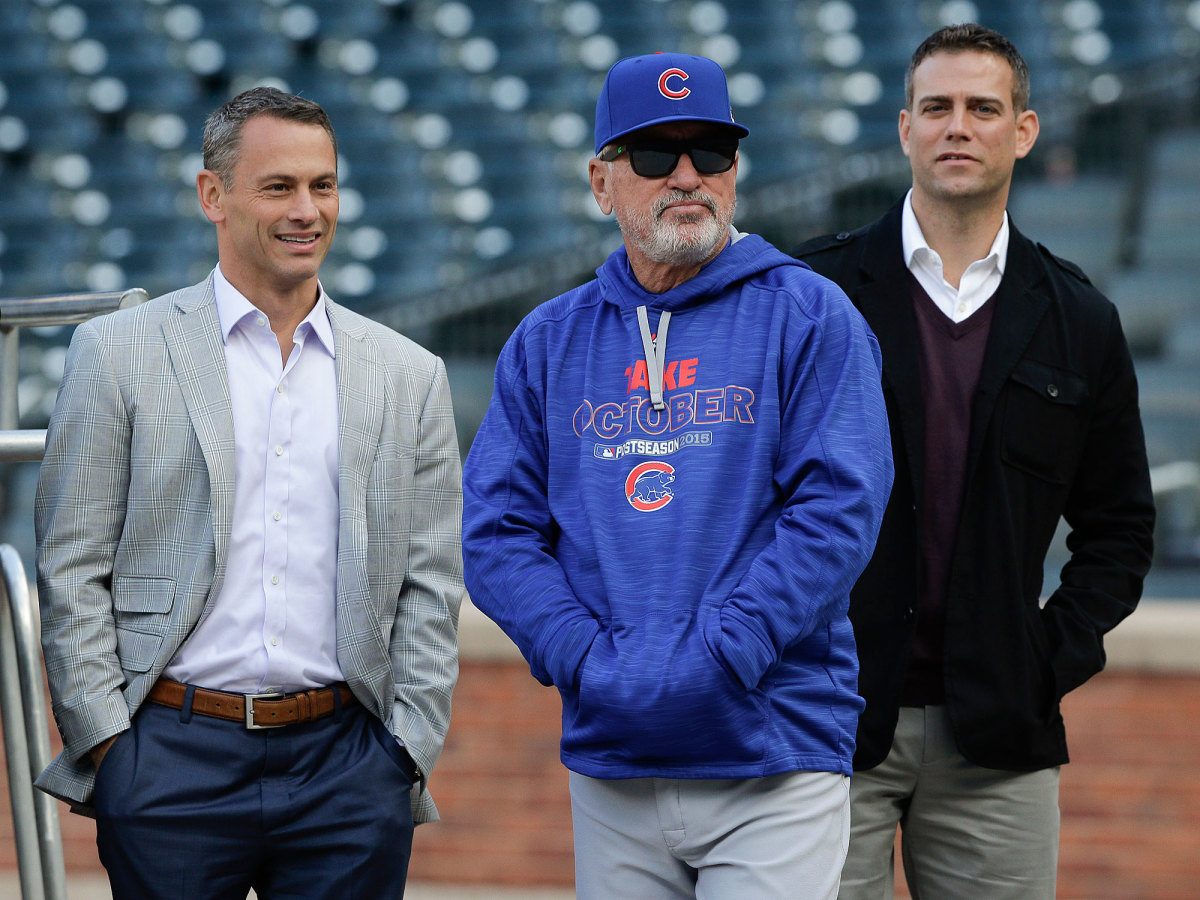
Despite falling short of the World Series for the 70th straight season, the Cubs sprinted to a 39–15 start this year, sparking talk that they were among the best teams of all time. Though Chicago has since cooled off, it still leads the majors in wins with 70 and has an MLB-high 12-game division lead.
So how did the roster come together? Three players—catcher Willson Contreras, infielder Javier Baez and outfielder Matt Szczur—were holdovers from the previous administration. The rest of this year's current 25-man roster was assembled by Epstein and Co. thanks to 12 trades, eight free-agent signings that cost $495 million, one amateur draft pick and one Rule 5 draft pick. The result is the best team in baseball. Here’s a detailed look at the front office’s five-year odyssey. This is how the Cubs were built.
NOTE: Other than for starting pitchers, the graphics below begin with the player that Epstein and Co. inherited at the end of the 2011 season and trace through each different player who played the majority of the games at each spot before ending on the player who fits that description on the current roster. All statistics are through Tuesday, Aug. 9.
• How the Cubs' starting lineup has evolved over the years under Epstein
Catcher
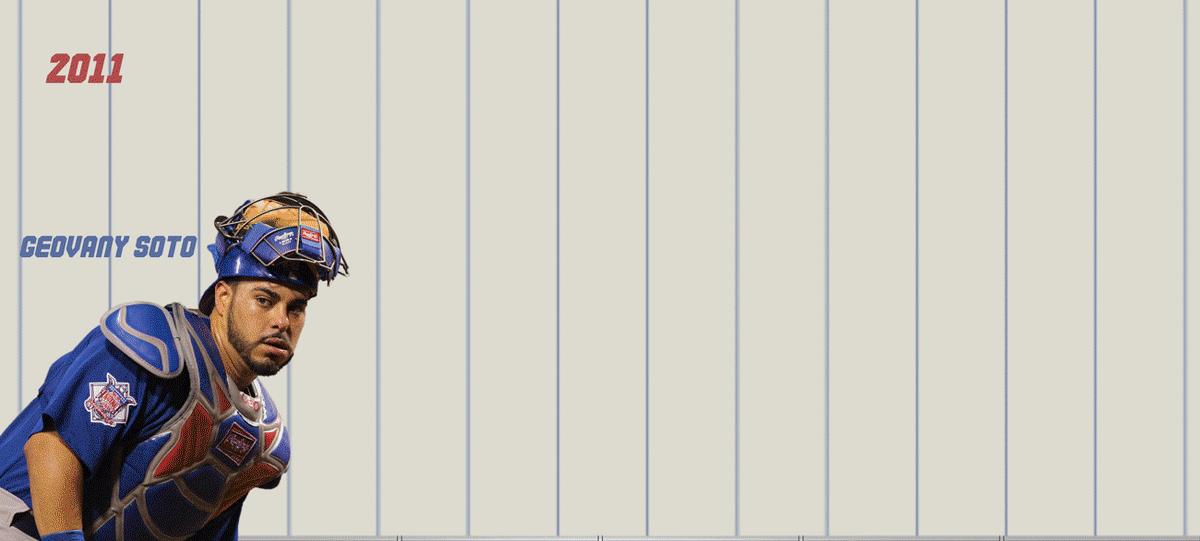
Inherited:Geovany Soto (traded to the Texas Rangers on July 31, 2012 for minor league righthanded pitcher Jake Brigham and a player to be named later or cash)
2016 Roster:Miguel Montero (acquired in a trade with the Arizona Diamondbacks on Dec. 9, 2014); Willson Contreras (signed as an amateur free agent in 2009); David Ross (signed as a afree agent to two-year, $5 million contract, Dec. 19, 2014)
Breakdown: Geovany Soto had won the NL’s Rookie of the Year award in 2008, but injuries and poor conditioning sapped his production and his availability in subsequent seasons. He posted a mere 70 OPS+ for the Cubs in 2012 before they let the Rangers have him at the trading deadline, handing primary catching duties to rookie Welington Castillo. Castillo had a powerful bat and a strong arm, but he was a poor pitch-framer, and when his hitting went south in 2014, Chicago soured on him, ultimately dumping him on the Mariners in May 2015.
Prior to that season, the Cubs had traded for ace framer Miguel Montero, sending a pair of minor league righties acquired in 2013—10th-round pick Zack Godley and international signee Jeferson Mejia—to Arizona and assuming the remaining three years and $40 million left on the then-31-year-old Montero’s contract. Off to a poor start at the plate this year, Montero appears to be in the process of losing his job to 24-year-old rookie Willson Contreras, who was signed out of Venezuela by the previous administration in 2009 and was considered the team’s second-best prospect coming into this season. David Ross, a free-agent pickup, has served as Jon Lester's personal catcher.
First base
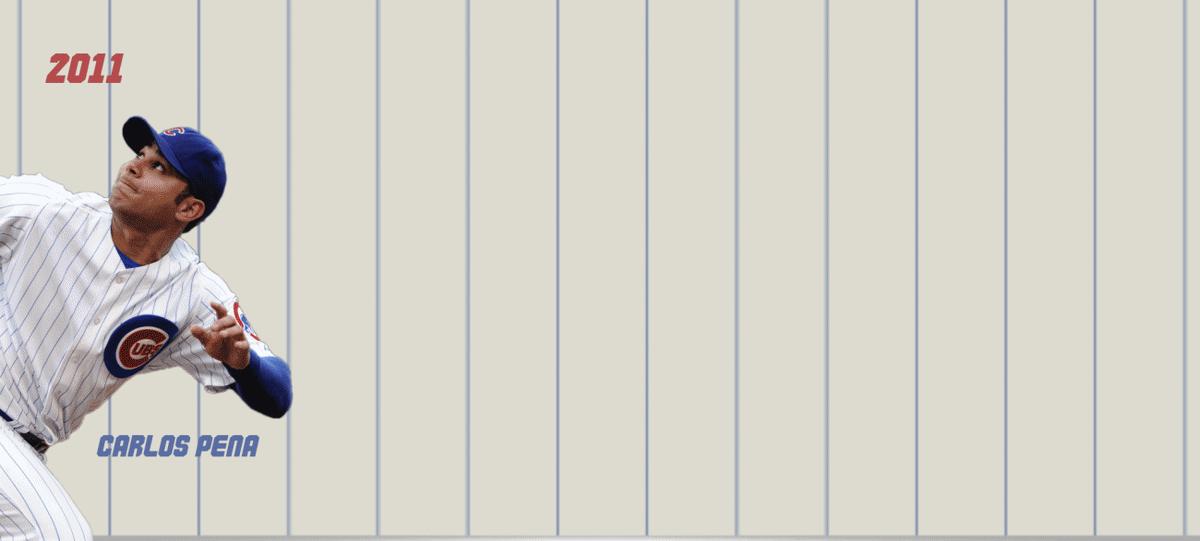
Inherited:Carlos Pena (signed a one-year, $7.25 million contract as a free-agent with the Tampa Bay Rays on Jan. 20, 2012)
2016 Roster: Anthony Rizzo (acquired in a trade with the San Diego Padres on Jan. 6, 2012 with minor league righthanded pitcher Zach Cates for righthanded pitcher Andrew Cashner and minor league outfielder Kyung-Min Na)
Breakdown: Carlos Pena hit a team-high 28 home runs in 2011, but the new regime let him walk after the season. Barely two months into their tenure they acquired the first regular of the 2016 team by making a trade with the Padres for power-hitting prospect Anthony Rizzo. Epstein and Hoyer had drafted Rizzo out of high school in 2007 while with the Red Sox, and Hoyer had then acquired him from Boston in '10 after becoming San Diego’s GM the previous year.
Rizzo needed more time in the minors, so the Cubs opened the 2012 campaign with Bryan LaHair, a journeyman who had played only 65 big league games to date, as their starting first baseman. LaHair's first six weeks were so torrid that he wound up on the NL All-Star team, but by the time of the game, he had already been pushed to the outfield by the June arrival of Rizzo. The lefty-swinging slugger has since blossomed into a three-time All-Star and was signed to a seven-year, $41-million contract in 2013 that, with club options, could keep him in Chicago through at least '21.
Den Leader: Slugger and cancer survivor Anthony Rizzo holds the Cubs together
Second Base
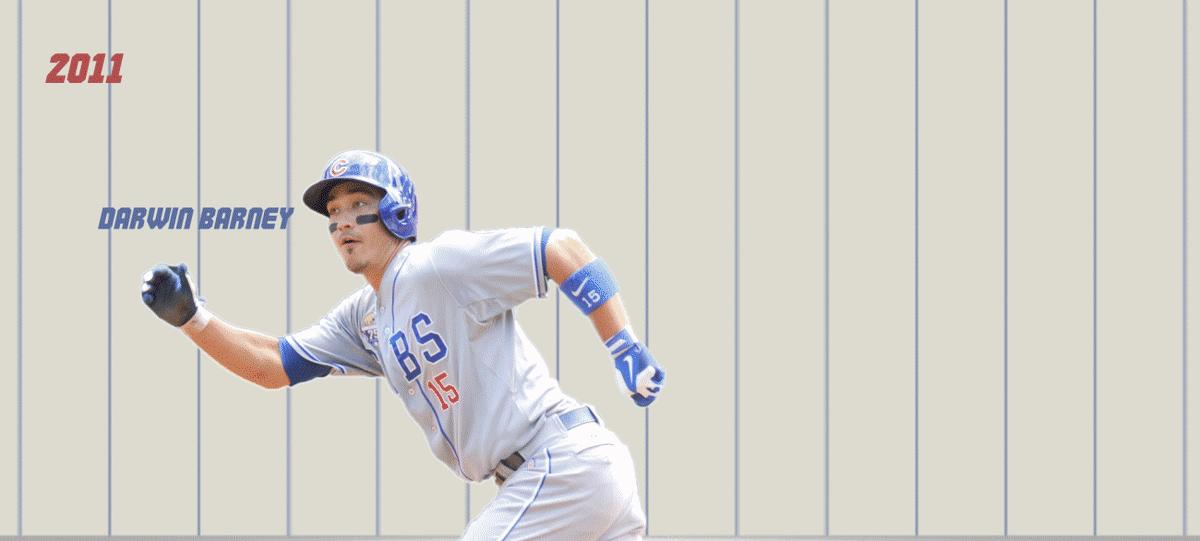
Inherited:Darwin Barney (traded to the Los Angeles Dodgers on July 28, 2014 for a PTBNL, which became minor league righthander Jonathan Martinez)
2016 Roster:Ben Zobrist (signed as a free-agent to a four-year, $56 million contract on Dec. 9, 2015)
Breakdown: Good-field no-hit Darwin Barney was a deserving Gold Glove winner in 2012, but his bat cratered in '13, and he was designated for assignment and traded to the Dodgers just before the '14 non-waiver deadline. After his departure, prospects Arismendy Alcantara, an international signee in 2008, and Javier Baez, the No. 9 pick in '11, got looks at the keystone, but both struck out at alarming rates and failed to secure the job.
Alcantara opened the 2015 season at second, but he was just a place-holder for 21-year-old Addison Russell, who made his major league debut as the team’s starting second baseman on April 21, five days after the cutoff for a full year of service time. Russell was an elite shortstop prospect who had been acquired the previous July from Oakland in a five-player trade. When incumbent shortstop Starlin Castro was benched in early August, Russell returned to his natural position, with Castro soon moving to second and putting together a strong finish to the season. Last December, the Cubs signed veteran Ben Zobrist to a four-year, $56 million deal and traded Castro and the four years and $38 million remaining on his contract to the Yankees. The net effect of that swap was not only to give Chicago a far superior player—Castro was worth 2.3 wins his last three years in Chicago; Zobrist has produced 2.8 WAR for the Cubs this year alone—but also to do so for a mere $18 million over four years.
Shortstop
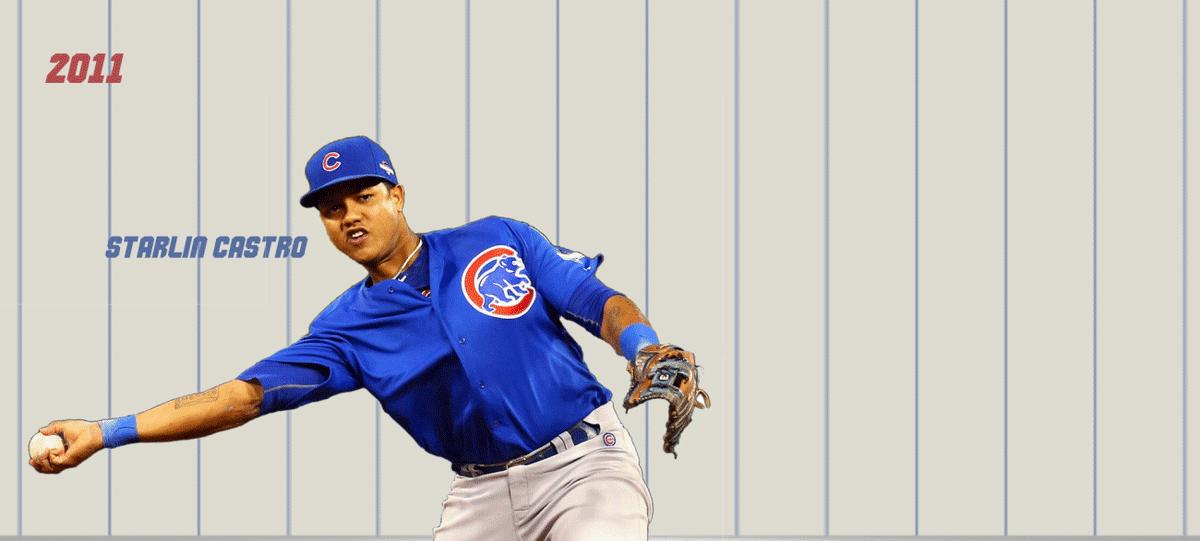
Inherited: Starlin Castro (traded to the New York Yankees on Dec. 8, 2015 for righthanded pitcher Adam Warren and a PTBNL, who became second baseman Brendan Ryan)
2016 Roster:Addison Russell (acquired in a trade from the Oakland Athletics on July 8, 2015 with minor league outfielder Billy McKinney and righthanded pitcher Dan Straily for righthanded pitchers Jason Hammel and Jeff Samardzija)
Breakdown: When Epstein and Hoyer joined the Cubs in October 2011, the franchise’s greatest asset was Starlin Castro, a 21-year-old All-Star shortstop who had just become the youngest player ever to lead the NL in hits. Castro had another All-Star season in 2012, prompting the new administration to sign him to a seven-year, $60 million extension that August. Instead of blossoming into a superstar in his mid-20s, however, Castro regressed. Either distracted, indifferent, absent-minded or all of the above, he sank to replacement level in 2013, and though he rebounded with another All-Star campaign in ‘14, he collapsed again in ‘15. The August benching and move to second base seemed to jumpstart him, but with Russell, a vastly superior fielder, having assumed the shortstop job, the team was ready to move on and did so, dealing Castro to the Yankees. The organization will now wait to see if the 22-year-old Russell can mature at the plate in ways Castro didn’t. The early returns have been encouraging, as Russell made the NL All-Star team this year.
• The Untouchables: The one player each NL team should not trade | AL
Third base
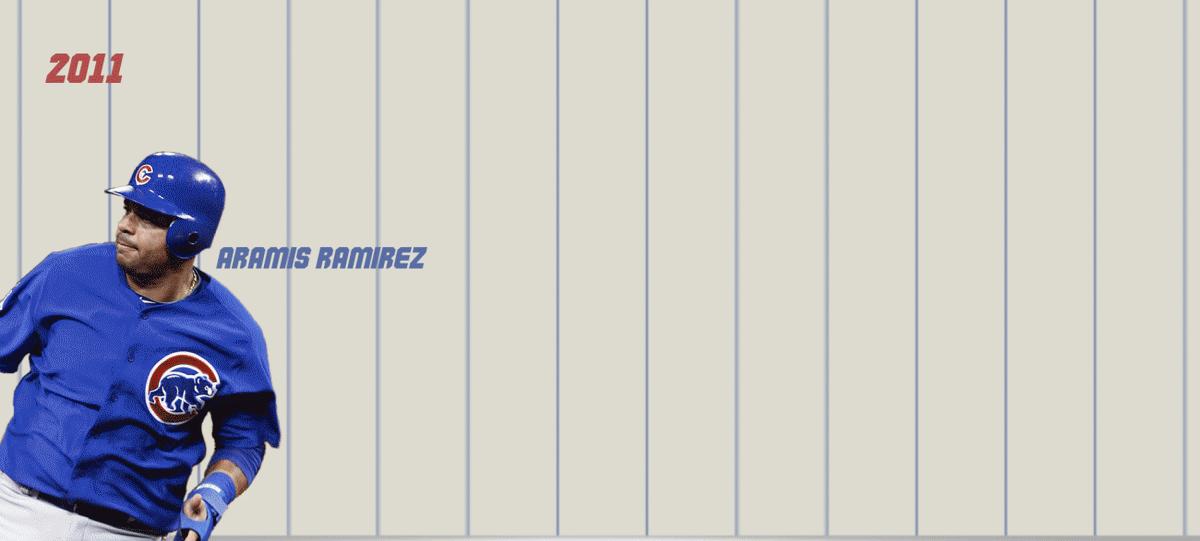
Inherited: Aramis Ramirez (signed a three-year, $36 million contract as a free agent with the Milwaukee Brewers on Dec. 12, 2011)
2016 Roster: Kris Bryant (selected with the No. 2 pick in the 2013 MLB draft); Javier Baez (selected with the No. 9 pick in the 2011 MLB draft)
Breakdown: Aramis Ramirez, who had held the Cubs' hot corner job since mid-2003, put up a strong season at age 33 in '11, hitting .306/.361/.510 with 26 home runs and leading the team in RBIs (93) and OPS (.871). Like Pena, though, the new regime let him leave in free agency at season’s end. The same day he signed with Milwaukee, the Cubs acquired 26-year-old Ian Stewart from the Rockies. Stewart, who had been a Baseball America top-100 prospect in five straight years from 2004 to ’08, started the year at third, but he hit poorly and was lost for the season in mid-June due to left wrist surgery. Light-hitting utilityman Luis Valbuena took over and served as the long half of a platoon through the 2014 season. For the remainder of 2012, he paired with 2007's No. 3 draft pick, Josh Vitters (who utterly flopped, posting a .395 OPS in 36 games); in '13 his partner was journeyman Cody Ransom; and in ’14 it was fizzled prospect Mike Olt, who had been the biggest name brought back in a deadline trade the previous year that sent starter Matt Garza to the Rangers.
Olt and utiltyman Jonathan Herrera started the 2015 season with the job until Kris Bryant, the No. 2 pick in the '13 draft, could be promoted without gaining a full year of service time. Bryant came up in mid-April and quickly lived up to the hype, winning NL Rookie of the year honors after hitting 26 home runs and driving in 99 runs. In 2016, he has emerged as a leading MVP candidate.
• Verducci: Title-hungry teams go all in at the trade deadline
Leftfield
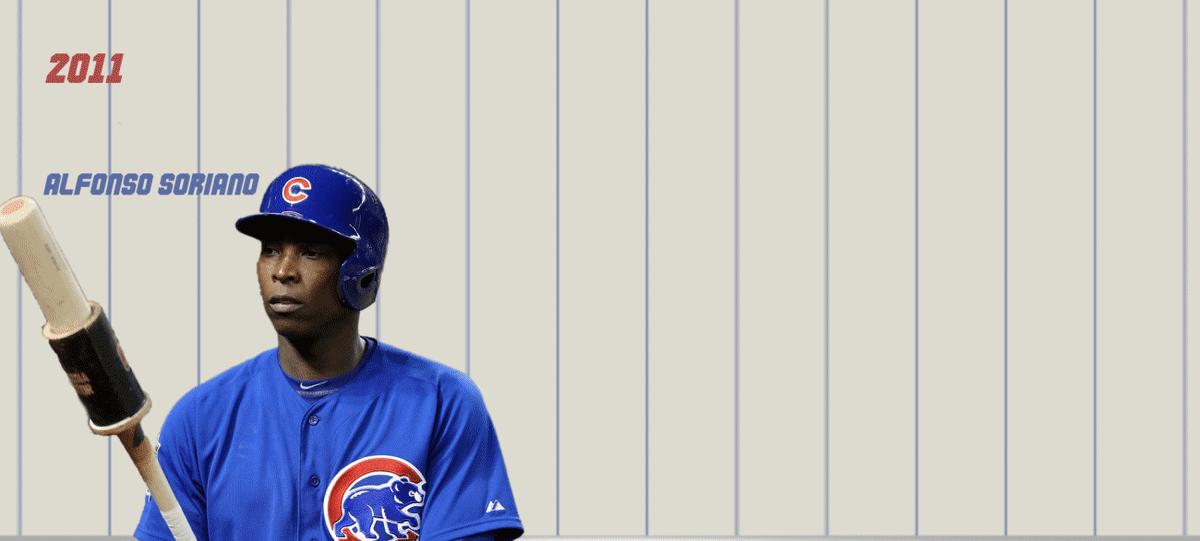
Inherited: Alfonso Soriano (traded to the New York Yankees on July 26, 2013 for minor league righthanded pitcher Corey Black)
2016 Roster:Jorge Soler (signed as an international free agent in 2012); Chris Coghlan (acquired in a trade with the Oakland A's on June 9, 2016 for infielder/outfielder Arismendy Alcantara); Matt Szczur (selected in the fifth round of the 2010 MLB draft)
Breakdown: By the end of the 2011 season, Alfonso Soriano had become an expensive, sub-replacement-level millstone, but he still had three years and $54 million remaining on his eight-year, $136 million contract. His play rebounded slightly over the next season and a half, bolstering his value such that he was traded to the Yankees, his original team, in late July 2013, saving the Cubs about $7 million. That cleared a spot for Junior Lake, just in time for the league to catch up to him after a sizzling first week in the majors.
Lake opened 2014 sharing the job with Ryan Kalish, who had been drafted by Epstein’s regime in Boston, but by the end of May, former NL Rookie of the Year Chris Coghlan claimed the majority of the playing time. Coghlan held onto that spot through the first half of 2015, until prospect Kyle Schwarber, the No. 4 pick in the 2014 draft as a catcher, forced his way into the lineup with his light-tower power. Schwarber opened the 2016 season in leftfield but tore his ACL in the season's third game and is out for the year. Since then, the job has been shared by, among others, Jorge Soler (who was displaced from rightfield by the Jason Heyward signing), Bryant (when he’s not playing third), Coghlan (who had been reacquired from the A's), Contreras (when he’s not catching) and Matt Sczur.
Centerfield
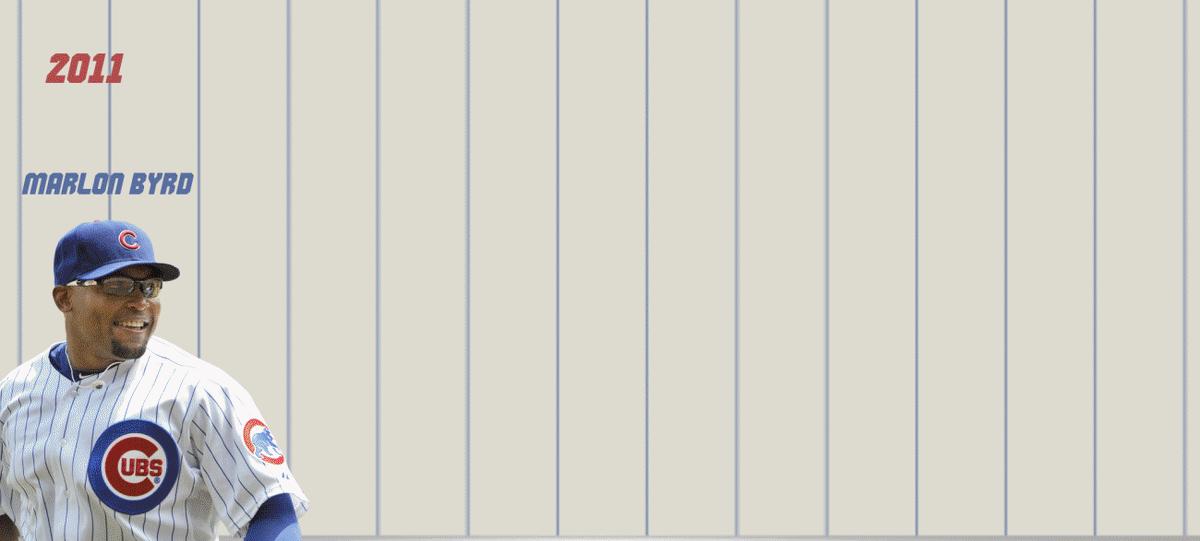
Inherited: Marlon Byrd (traded to the Boston Red Sox on April 21, 2012 for righthanded pitcher Michael Bowden, cash and a PTBNL)
2016 Roster: Dexter Fowler (acquired in a trade with the Houston Astros on Jan. 19, 2015 for righthanded pitcher Dan Straily and infielder Luis Valbuena)
Breakdown: In the final year of a three-year, $15 million contract, Marlon Byrd opened the 2012 season by going 3 for 43, at which point the new administration ate the remainder of his salary and shipped him to Boston. After using speedy rookie Tony Campana and veteran David DeJesus—who had signed a two-year, $10.5 million deal prior to the season—as placeholders, the Cubs called up 24-year-old centerfield prospect Brett Jackson that August. Jackson looked completely overmatched, however, and was traded to Arizona at season’s end and is now out of pro ball.
In 2013, Chicago opened the year with DeJesus in center but sold him to the Nationals in August and finished the season with journeyman Ryan Sweeney at the position. The next year saw speedy utilityman Emilio Bonifacio steal the centerfield job with a hot start before yielding to a hodgepodge that would include himself, Sweeney, Lake and journeyman Justin Ruggiano until the team gave Alcantara an extended look down the stretch. The net result was a brutal .222/.264/.346 line from the position on the 2014 season, prompting the Cubs to acquire Dexter Fowler, entering his walk year, from the Astros in exchange for third baseman Luis Valbuena and righty Dan Straily.
After the 2015 season, the Cubs made Fowler a qualifying offer worth $15.8 million for one year. The associated draft pick compensation killed the market for his services, prompting him to re-sign with Chicago in late February on a one-year contract worth a guaranteed $13 million but with a mutual option for 2017 that would add only $4 million to the overall value of the deal if it's picked up.
Rightfield
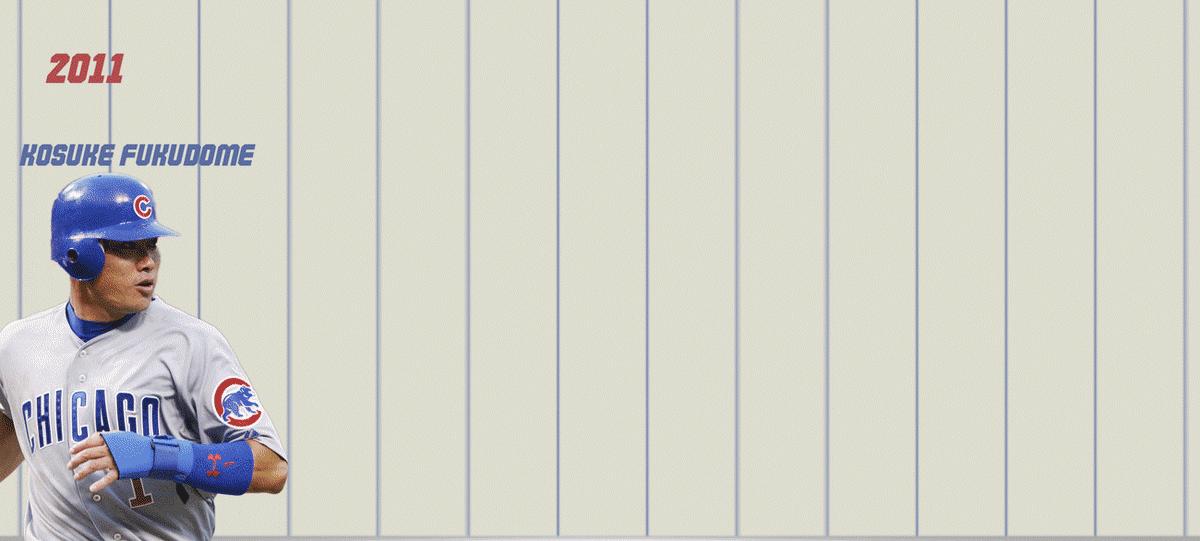
Inherited: Tyler Colvin (traded with infielder D.J. LeMahieu to the Colorado Rockies for minor league righthanded pitcher Casey Weathers and third baseman Ian Stewart)
2016 Roster:Jason Heyward (signed to an eight-year, $184 million contract as a free agent on Dec. 15, 2015)
Breakdown: After the previous regime traded Kosuke Fukudome to the Indians at midseason in 2011, the Cubs closed that season with Tyler Colvin, LaHair and Reed Johnson in the mix in rightfield. LaHair and DeJesus took most of the time there in 2012. In 2013 and '14, low-cost free agent Nate Schierholtz held down the long half of a platoon, paired primarily with Scott Hairston (who was traded to the Nationals in July 2013), Ruggiano (acquired from the Marlins in December '13) and Sweeney (a '13 spring training cut by the Red Sox). After hitting .192 in 99 games, Schierholtz was designated for assignment in August of 2014; later that month, Soler, a Cuban defector whom the team had signed to a nine-year, $30 million deal in June 2012, debuted and held the job through the final two months of that season and most of 2015. That December, the team signed Heyward to an eight-year, $184 million deal. He’s struggled mightily, producing the fifth-lowest OPS (.633) in the NL.
Starting Rotation
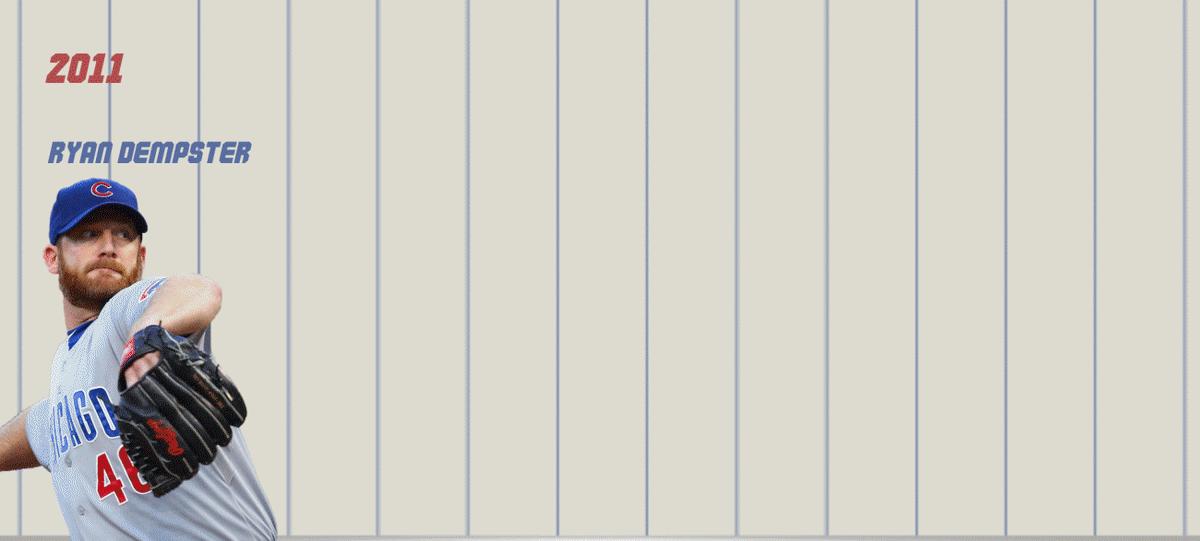
NOTE: Pictured above are key members of the team's rotation for each season.
Inherited
Ryan Dempster: Traded to the Texas Rangers on July 31, 2012 for minor league infielder Christian Villanueva and minor league righthanded pitcher Kyle Hendricks
Matt Garza: Traded to the Texas Rangers on July 22, 2013 for minor league pitchers Carl Edwards and Justin Grimm, minor league third baseman Mike Olt and a PTBNL
Carlos Zambrano: Traded with cash to the Miami Marlins on January 5, 2012 for righthanded pitcher Chris Volstad
Randy Wells: Signed minor league contract with the Texas Rangers as a free agent on Dec. 6, 2012
Casey Coleman: Released on April 14, 2014
2016 Roster
Jake Arrieta: Acquired with righthanded pitcher Pedro Strop in a trade with the Baltimore Orioles on July 2, 2013 for catcher Steve Clevenger and righthanded pitcher Scott Feldman
Jon Lester: Signed as a free-agent to a six-year, $155 million contract on Dec. 14, 2014
Kyle Hendricks: Acquired with minor league infielder Christian Villanueva in a trade with the Texas Rangers on July 31, 2012 for righthanded pitcher Ryan Dempster
John Lackey: Signed as a free-agent to a two-year, $32 million contract on Dec. 8, 2015
Jason Hammel: Signed as a free-agent to a two-year, $20 million contract on Dec. 12, 2014
Breakdown: Travis Wood was acquired from the Reds in December 2011 in just the second trade that Epstein and Hoyer made. He served as a rotation staple for the next three seasons and remains a useful reliever for Chicago. In the new regime's third trade, in January 2012, they dumped Carlos Zambrano—the staff's enfant terrible—on the Marlins for Chris Volstad. Zambrano had been suspended by the team after an Aug. 12, 2011 meltdown in which he gave up five home runs to Atlanta, threw at the Braves' Chipper Jones, said he was retiring and cleaned out his locker. He was suspended 30 games and never pitched again for Chicago, which had to eat $15.5 million of his remaining salary. At the July 2012 trading deadline, the Cubs sent holdovers Paul Maholm to Atlanta and Ryan Dempster to Texas (with prospect Kyle Hendricks, now their No. 3 starter, as one of the return pieces from the Rangers).
In the fall of 2012, Chicago signed two pitchers. One would lead to the best acquisition of Epstein’s tenure, and the other was, by itself, the worst free-agent signing he has made to date. In November, the Cubs signed righthander Scott Feldman; in December they inked journeyman righty Edwin Jackson to a four-year, $52 million contract. Jackson was 3.6 wins below replacement level in two seasons as a starter before being shifted to the bullpen, before he was finally released in late July 2105 with about $15 million remaining on the deal. In July 2013, Feldman and catcher Steve Clevenger were flipped to the Orioles in exchange for Jake Arrieta, a well-regarded righthander who had yet to make good in the majors, and hard-throwing reliever Pedro Strop. Three weeks later, Matt Garza was sent to Texas in a deal that brought back 2016 relievers Justin Grimm and Carl Edwards. At the 2014 trade deadline, Jeff Samardzija and Jason Hammel, whom the Cubs had signed as a free agent that February, were traded to Oakland in a blockbuster that brought back shortstop prospect Addison Russell.
After the 2014 season, the Cubs reacquired Hammel via free agency and signed Jon Lester to a six-year, $155 million deal to be their frontline starter. He teamed with Arrieta, who dominated en route to the 2015 NL Cy Young Award, in giving the Cubs a potent 1–2 punch atop the rotation. This past winter, Epstein and Hoyer signed free agent John Lackey to a two-year, $32 million deal.
Closer
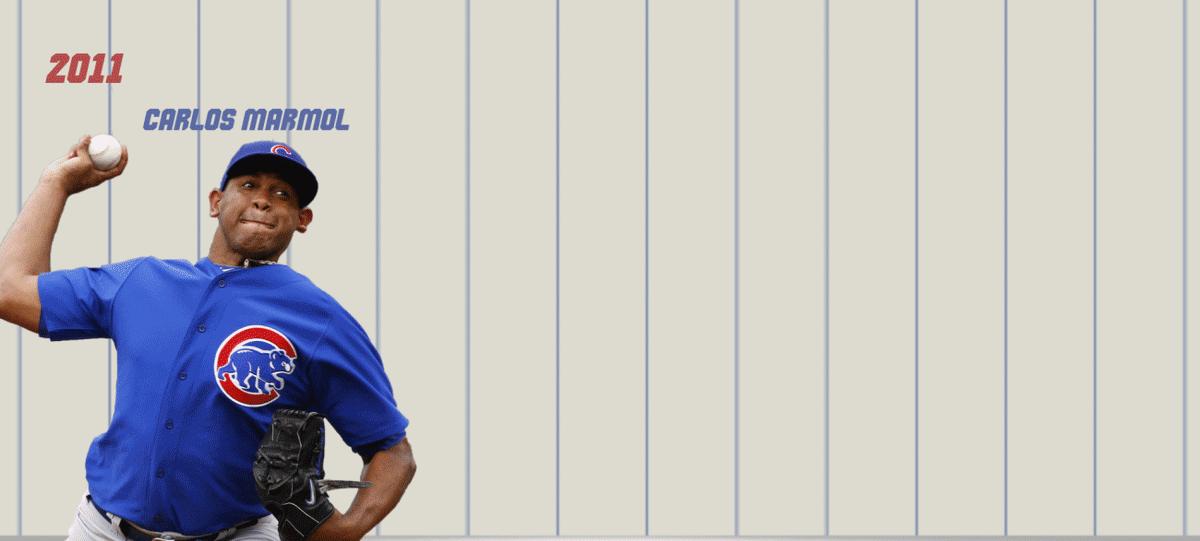
Inherited:Carlos Marmol (traded to the Los Angeles Dodgers on July 2, 2013 for righthanded pitcher Matt Guerrier)
2016 Roster:Aroldis Chapman (acquired in a trade with the New York Yankees on July 25, 2016 for righthanded pitcher Adam Warren and minor league outfielders Rashad Crawford and Billy McKinney and minor league infielder Gleyber Torres)
Other relievers
Carl Edwards Jr: Acquired with minor league pitcher Justin Grimm, minor league third baseman Mike Olt and a PTBNL in a trade with Texas Rangers on July 22, 2013 for righthanded pitcher Matt Garza
Mike Montgomery: Acquired with minor league righthanded pitcher Jordan Pries in a trade with the Seattle Mariners on July 20, 2016 for minor league righthanded pitcher Paul Blackburn and minor league first baseman Dan Vogelbach
Hector Rondon: Selected from the Cleveland Indians in the Rule 5 draft on Dec. 6, 2012
Joe Smith: Acquired in a trade with the Los Angeles Angels on Aug. 1, 2016 for minor league righthanded pitcher Jesus Castillo
Pedro Strop: Acquired with righthanded pitcher Jake Arrieta in a trade with the Baltimore Orioles on July 2, 2013 for catcher Steve Clevenger and righthanded pitcher Scott Feldman
Travis Wood: Acquired with outfielder Dave Sappelt and minor league infielder Ronald Torreyes in a trade from the Cincinnati Reds for lefthanded pitcher Sean Marshall on Dec. 23, 2011
Breakdown: The control-challenged Carlos Marmol walked 7.3 men per nine innings in 2012, prompting the Cubs to sign Japanese closer Kyuji Fujikawa to a two-year, $9.5 million contract that December. But Fujikawa struggled early in 2013 and blew out his elbow by the end of May, by which point former Cubs closer Kevin Gregg, who had been signed to a minor league deal in April, had already assumed the job. Marmol was traded to the Dodgers in July, and Gregg left as a free agent after the season. In 2014, Pedro Strop, who came over from the Orioles in the Jake Arrieta trade, got the first chance at the job, but though he remains a key part of Chicago’s bullpen, he didn’t last long as closer.
Taking his place was Hector Rondon. Elbow injuries had limited him to 10 minor league innings from May 2010 through the '12 season, but the Cubs took a flier on him by selecting him from the Indians in the Rule 5 draft. Chicago stuck with him through a lousy 2013 season and was rewarded when his velocity spiked into the upper 90s at the end of that year. Since the start of the 2014 season, Rondon has posted a 1.95 ERA, 0.95 WHIP and 5.23 strikeout-to-walk ratio and converted 77 of 89 save opportunities. On July 25, he was bumped into a setup role when the Cubs acquired flamethrowing closer Aroldis Chapman from the Yankees. Chicago’s top prospect, 19-year-old shortstop Gleyber Torres, went back to New York in the trade, along with outfielder Billy McKinney, former 11th-round pick Rashad Crawford and swingman Adam Warren. Chapman was part of a bullpen infusion before the trade deadline that also included lefty Mike Montgomery, a former first-round pick, and righty Joe Smith.
